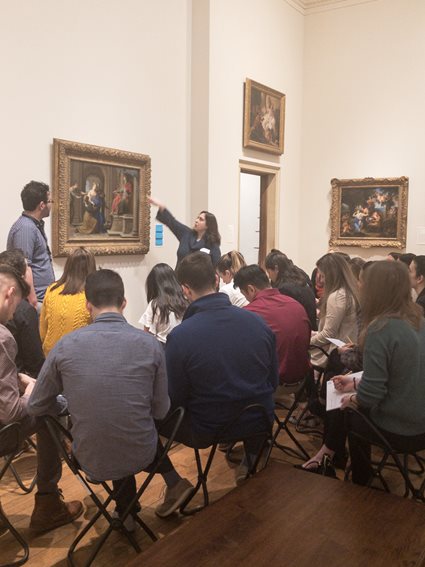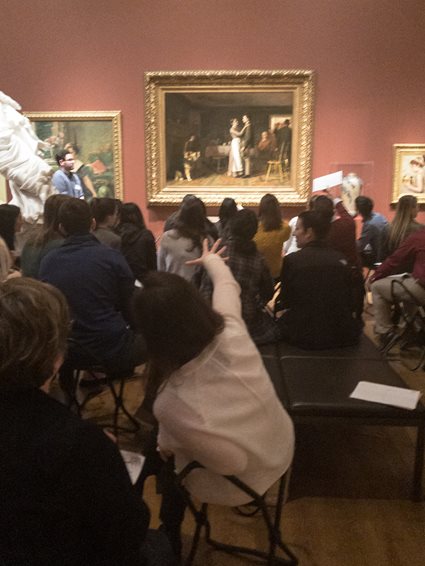Earlier this month, students from the University’s Physician Assistant Studies (PA) program visited the Philadelphia Museum of Art to participate in the second session of a workshop series known as the Art of Observation.
Facilitated by the museum’s educators, Adam Rizzo and Suzannah Niepold, the workshops were designed to help students improve their critical skills related to observation, listening, interpretation, communication and empathy with the intent of applying the same skills to the clinical practice of medicine.
Presented in three modules, students participated in the first session of the workshop series in the fall. It focused on having the students engage in an observation and visual breakdown of a specific painting – without providing subjective input or judgment.
When the students returned to the Art Museum for the second workshop, Rizzo and Niepold took the exercises to the next level. The students were instructed to refine their observation skills by looking for evidence to support their interpretation of the artwork.
Dalton Laut ‘20PA said, "I'm excited to build on our experiences from last time and move more from just the observation into interpretation."
 Students were led into the gallery to view two different paintings. With the title, artist, and year covered, they were asked to objectively describe what they saw. The group was then asked to subjectively interpret what was portrayed in the artwork.
Students were led into the gallery to view two different paintings. With the title, artist, and year covered, they were asked to objectively describe what they saw. The group was then asked to subjectively interpret what was portrayed in the artwork.
After the students completed their discussion and agreed on some ideas of what the painting could represent, Rizzo and Niepold revealed the artist, title, year, and the creator’s intention behind the artwork. As a result, some of the group’s assumptions were accurate, however, they learned some of their beliefs were not.
One of the lessons of this exercise was to illustrate the importance of not making assumptions in practicing medicine. Another was to check one’s personal biases when interacting with patients and their families. During the debriefing, PA assistant professor, Adam Moore, made the connection to examining x-rays. He explained how an image could present as something at first glance, but upon further investigation, could indicate a different diagnosis.
Another takeaway was the importance of collaboration and interprofessional relationships. As future healthcare providers, it is important for students to be able to efficiently work together to collect – and properly communicate – information about their patients.
“This exercise is a really good example of taking in all of the pieces,” PA associate professor Rachel Ditoro said. “Listening to other people’s interpretation and understanding of what they see and what they found, so that you don’t lose track of the fact that what you thought could actually be wrong.”
For the final exercise, students were asked to compare and contrast their observations of an early 17th century Beijing Palace reception hall and a room installation from the Chateau Draveil outside of Paris from the same period. The Chinese Hall was constructed from rustic wooden beams, full of nature and dragon imagery, intricately detailed jade and porcelain, and lacquered cabinetry. The grand salon in contrast was decorated in gilded crown molding, an opulent crystal chandelier, mirrors on every wall, and sculpted reliefs of cherubs above the doors.
 While the two rooms appeared very different from each other, each held the same cultural significance – they were both designed to show wealth. Without providing contextual information about the rooms, the connection between the two might be difficult to make. The importance of this exercise, noted Rizzo and Niepold, was for the students to be aware of their own biases, and the cultural and language barriers they may experience with patients.
While the two rooms appeared very different from each other, each held the same cultural significance – they were both designed to show wealth. Without providing contextual information about the rooms, the connection between the two might be difficult to make. The importance of this exercise, noted Rizzo and Niepold, was for the students to be aware of their own biases, and the cultural and language barriers they may experience with patients.
As the second session came to a close, student feedback remained overwhelmingly positive. “I’m excited to have this art observation experience. It’s a nice change of pace from just being in the classroom,” Zachary Seaman ‘20PA said. “Also, it helps us train our eyes to always be on the lookout for things we might not be expecting. When we see a patient, it’s important to never have a preconceived notion of how the patient should present. It’s good to hear other people’s perspectives on how they might interpret the art so that we can relate that to patient experience.”